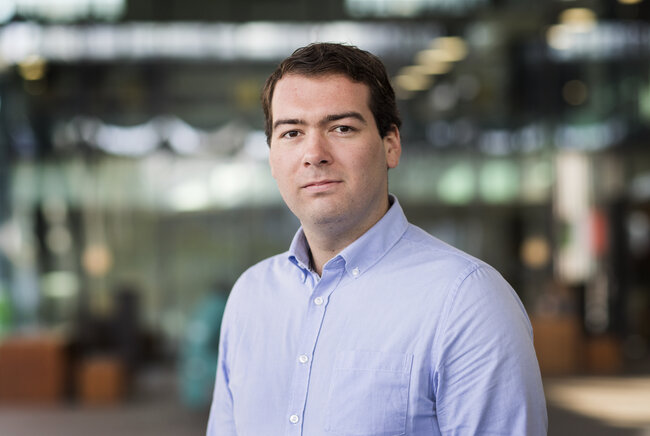Reduction of combusted iron using hydrogen
Conrad Hessels defended his PhD thesis at the department of Mechanical Engineering on May 15th.

In addition to production of wind and solar energy, the switch to renewable energy also requires a way to efficiently store and transport large amounts of energy. Cyclic combustion and reduction of iron powder may just be the solution for this, especially for seasonal storage and intercontinental transport. Iron is a common material, is cheap, non-toxic, and can most likely be burned (in powder form) in existing coal-fired power stations with minimal modification. The burnt iron powder (now iron oxide) can easily be captured and reduced (‘regenerated’) using green hydrogen. The use of iron powder as an energy carrier for sustainable energy has been designated as an icon project for Eindhoven University of Technology. In 2018 Conrad Hessels was the first PhD candidate to start this research, with TU/e now certainly leading the way internationally.
In this study, the reduction process, in which the sustainable energy is put into the powder, has been researched. Combusted powder is studied in different reactors of different sizes. First, a small amount of burnt powder was suspended from a very precise scale, while it reacts with hydrogen. The hydrogen strips the burnt iron powder (iron oxide) of the stored oxygen/oxide and to form water vapour. The energy is thereby transferred into the iron powder. As the oxygen disappears from the powder, it becomes lighter. Because it hangs from a scale, the reaction can be followed very accurately in real-time. By doing this at different temperatures and at different hydrogen concentrations, the reaction behaviour can be better understood. Based on the results, a reaction model was then developed.
Understanding the sintering process
The second step was to investigate the sintering behaviour of the powder. When iron powder heats up, it becomes malleable and even sticky. The particles then stick/fuse together. This must be avoided because the powder must remain fine for the subsequent combustion process. It can also lead to the regeneration process being disrupted and reactors having to be shut down. To better understand this sintering process, the powder was placed in a furnace and sintered at different temperatures for both thirty minutes and an hour. The formed pellets were then placed in a compression testbench. The force required to break the pellets was then used to tune a model. This model can now be used to predict how much sintering will take place at different locations in the reactors. Because the sintering was performed in both hydrogen and nitrogen, the model can be applied for the entire cycle. Both for combustion and regeneration.
Investigation of fluidization behaviour
For practical application, the use of a fluidized bed is envisaged. In a fluidized bed, gas is sent through a bed of powder, causing the powder to behave like a boiling liquid (so-called fluidization). This ensures better mixing, heat transfer and reaction. To understand this more ‘practical’ setup, in the last part of the research a fluidized bed reactor was designed, and the fluidization behaviour investigated. In particular, the minimum gas velocity required for fluidization at elevated temperature differed from existing models. This research showed that this value can be accurately predicted by including the sintering behaviour (stickiness) of the particles in the force balance. With these new predictions, better reactors can be developed, and more accurate reaction research can be carried out.
The research has shown that renewable energy, with hydrogen as an intermediate step, can be stored in the powder. The produced powder can also be directly used for the combustion process. As a nice catch, this research also contributes to more sustainable steel production/industry, which is currently one of the most polluting industries.
Title of PhD thesis: ' Reduction of combusted iron using hydrogen'. Supervisors: Niels Deen, Yali Tang and Tess Homan.